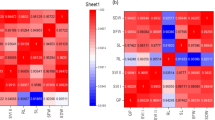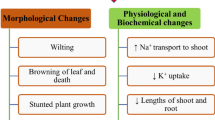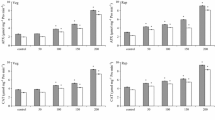Abstract
In order to study the adaptation ability of sweet sorghum (Sorghum bicolor L. Moench) in the Yellow River Delta, the sweet sorghum variety Mart was used in this study to determine the roles of different saline-alkaline ratio stress treatment during seed germination to seedling stage. The results showed that Na+ concentration had a significant impact on the seed germination, seedling growth, and plant survival of sweet sorghum. Increasing Na+ concentration led to a decline in germination rate, final germination percentage, survival percentage, plant height, and dry weight per plant, a prolonged mean time of germination, as well as loss of improvement effect of low-Na+ concentration. The interaction effect of Na+ concentration and pH on the mean time of germination and germination rate was not significant (p < 0.05). However, under the condition of low-Na+ concentration (100 mM), high pH reduced the mean time of germination and increased the germination rate, without decline in final germination percentage and survival percentage. Therefore, at least in the duration of seed germination to the harvest period in the research, the sweet sorghum was resistant to the pH stress (≥9.04) when the Na+ concentration was below 100 mM. When suffered from the saline-alkaline stress, the seedling of sweet sorghum was characterized by ecological adaptive features, such as decreased stem ratio and chlorophyll b content in leaves and increased root ratio and chlorophyll a content, in order to maintain the uptakes of water and nutrient, and carbon assimilation. When the stress intensified, the lipid oxidation products, e.g., malondialdehyde (MDA), increased in sweet sorghum seedlings. However, the increasing of soluble protein content and antioxidant enzyme activity (superoxide dismutase (SOD), guaiacol peroxidase (POD), and gatalase (CAT)) was only founded in neutral low-Na+ concentration treatment (A1), which indicated that high-salt concentration and pH all elicited harmful effects and limited the self-healing ability of sweet sorghum seedlings. In all, in order to grow sweet sorghum in the saline-alkaline soils of the Yellow River Delta, the salt concentration and pH value of the soil must be taken into consideration, and seeding density should be increased and supported by appropriate irrigation measures to reduce saline-alkaline stress so as to ensure the survival and growth of sweet sorghum seedlings.


Similar content being viewed by others
References
Ali, Y., Aslam, Z., Ashraf, M. Y., & Tahir, G. R. (2004). Effects of salinity on chlorophyII concentration, leaf area, yield and yield components of rice genotypes grown under saline environment. International Journal of Environmental Science & Technology, 1, 221–225.
Balal, R. M., Ashraf, M. Y., Khan, M. M., Jaskani, M. J., & Ashfaq, M. (2011). Influence of salt stress on growth and biochemical parameters of citrus rootstocks. Pakistan Journal of Botany, 43, 2135–2141.
Saadia, M., Jamil, A., Ashraf, M., & Akram, N. A. (2013). Comparative study of SOS2 and a novel PMP3-1 gene expression in two sunflower (Helianthus annuus L.) lines differing in salt tolerance. Applied Biochemistry and Biotechnology, 170, 980–987.
Liu, J., & Shi, D. C. (2010). Photosynthesis, chlorophyll fluorescence, inorganic ionand organic acid accumulations of sunflower in responses to salt and salt-alkaline mixed stress. Photosynthetica, 48, 127–134.
Yang, C., Chong, J., Li, C., Kim, C., Shi, D., & Wang, D. (2007). Osmotic adjustment and ion balance traits of an alkali resistant halophyte Kochia sieversiana during adaptation to salt and alkali conditions. Plant and Soil, 294, 263–276.
Yang, J. Y., Zheng, W., Tian, Y., Wu, Y., & Zhou, D. W. (2011). Effects of various mixed salt-alkaline stresses on growth, photosynthesis, and photosynthetic pigment concentrations of Medicago ruthenica seedlings. Photosynthetica, 49, 275–284.
Li, R., Shi, F., & Fukuda, K. (2010). Interactive effects of salt and alkali stresses on seed germination, germination recovery, and seedling growth of ahalophyte Spartina alterniflora (Poaceae). South African Journal of Botany, 76, 380–387.
Dkhil, B. B., & Denden, M. (2010). Salt stress induced changes in germination, sugars, starch and enzyme of carbohydrate metabolism in Abelmoschus esculentus (L.) Moench seeds. African Journal of Agricultural Research, 5, 408–415.
Khan, F., Hakeem, K. R., Siddiqi, T. O., & Ahmad, A. (2013). RAPD markers associated with salt tolerance in soybean genotypes under salt stress. Applied Biochemistry and Biotechnology, 170, 257–272.
Zhang, X. Q., Lu, Z. Y., Cheng, Y. C., Guo, X. X., Tian, L., Zhang, J. Z., et al. (2013). Effects of mixed salt stress on germination percentage and protection system of oat seedling. Advance Journal of Food Science and Technology, 5, 197–205.
Al-Khateeb, S. A. (2006). Effect of salinity and temperature on germination, growth and ion relations of Panicum turgidum Forssk. Bioresource Technology, 97, 292–298.
Vicente, M. J., Conesa, E., Álvarez-Rogel, J., Franco, J. A., & Martínez-Sánchez, J. J. (2009). Relationships between salt type and seed germination in three plant species growing in salt marsh soils of semi-arid Mediterranean environments. Arid Land Research and Management, 23, 103–114.
Gupta, P., Sharma, S., & Saxena, S. (2014). Effect of salts (NaCl and Na2CO3) on callus and suspension culture of steviarebaudiana for steviol glycoside production. Applied Biochemistry and Biotechnology, 172, 2894–2906.
Almodares, A., Hadi, M. R., & Dosti, B. (2008). The effects of salt stress on growth parameters and carbohydrates contents in sweet sorghum. Research Journal of Environmental Sciences, 2, 298–304.
Weng, Y., Gong, P., & Zhu, Z. (2008). Reflectance spectroscopy for the assessment of soil salt content in soils of the Yellow River delta of China. International Journal of Remote Sensing, 29, 5511–5531.
Sipos, B., Réczey, J., Somorai, Z., Kádár, Z., Dienes, D., & Réczey, K. (2009). Sweet sorghum as feedstock for ethanol production: enzymatic hydrolysis of steam-pretreated bagasse. Applied Biochemistry and Biotechnology, 153, 151–162.
Mastrorilli, M., Katerji, N., & Rana, G. (1999). Productivity and water use efficiency of sweet sorghum as affected by soil water deficit occurring at different vegetative growth stages. European Journal of Agronomy, 11, 207–215.
Steduto, P., Katerji, N., Puertos-Molina, H., Ünlü, M., Mastrorilli, M., & Rana, G. (1997). Water-use efficiency of sweet sorghum under water stress conditions gas-exchange investigations at leaf and canopy scales. Field Crops Research, 54, 221–234.
Wang, C. J., Li, Z. J., Wang, X. L., Jiang, C. D., Tang, Y. D., Gu, W. B., et al. (2011). Effects of salt stress on photosystem II activity in sweet sorghum seedlings grown in Pots outdoors. Acta Agronomica Sinca, 37, 2085–2093.
Patanè, C., Saita, A., & Sortino, O. (2013). Comparative effects of salt and water stress on seed germination and early embryo growth in two cultivars of sweet sorghum. Journal of Agronomy and Crop Science, 199, 30–37.
Fan, H., Wu, H. D., Zhou, M. L., Zhang, Y., Ding, T. L., & Wang, B. S. (2012). Planting sweet sorghum in Yellow River delta: the cultivation measure, yield and effect on soil microflora. Advanced Materials Research, 518–523, 81–87.
Ding, T. L., Song, J., Guo, J. R., Sui, N., Fan, H., Chen, M., et al. (2013). The cultivation technique for increasing the stalk sugar content of energy plant sweet sorghum in Yellow River delta. Advanced Materials Research, 724–725, 437–442.
Fan, H., Cheng, R. R., Wu, H. D., Cheng, S., Yan, J., Ding, T. L., et al. (2013). Planting sweet sorghum in Yellow River delta: agronomy characters of different varieties and the effects of sowing time on the yield and other biological traits. Advanced Materials Research, 726–731, 3–8.
Yang, M. W. (2002). Study on rapid determination of chlorophyll content of leaves. Chinese Journal of Spectroscopy Laboratory, 19, 478–481.
Rachmilevitch, S., DaCosta, M., & Huang, B. (2006). Physiological and biochemical indicators for stress tolerance. Plant-environment interactions (pp. 321–356). New York: CRC Taylor & Francis.
Li, H. S., Sun, Q., Zhao, S. J., & Zhang, W. H. (2004). Plant physiology biochemistry principle and experimental technique. Beijing: H Education Press.
Yang, C. W., Shi, D. C., & Wang, D. L. (2008). Comparative effects of salt and alkali stresses on growth, osmotic adjustment and ionic balance of an alkali-resistant halophyte Suaeda glauca (Bge.). Plant Growth Regulation, 56, 179–190.
Lachhab, I., Louahlia, S., Laamarti, M., & Hamman, K. (2013). Effect of salt stress on germination and enzyme activity in two genotypes of Medicago sativa. International Journal of Innovation and Applied Studies, 3, 511–516.
Zhang, Z. L. (2002). Plant physiology experimental guide. Beijing: Higher Education Press.
Wang, N., Cao, M. J., Wang, J., & Li, B. F. (2009). Difference of germination and seedling growth of maize under NaCl and Na2CO3+NaHCO3. Corps, 4, 52–56.
Bacchetta, G., Bueno Sánchez, A., Fenu, G., Jiménez-Alfaro, B., Mattana, E., Piotto, B., & Virevaire, M. (Eds). (2008). Conservación ex situ de plantas silvestres. Principado de Asturias/La Caixa.
Luque, E. G., Fernández, I. C. D., & Mercado, F. G. (2013). Effect of salinity and temperature on seed germination in Limonium cossonianum. Botany, 91, 12–16.
Khan, M. A., & Ungar, I. A. (1997). Effects of thermoperiod on recovery of seed germination of halophytes from saline conditions. American Journal of Botany, 84, 279–283.
Salami, M., Asli, D. E., & Rad, M. Y. (2013). Impact of hydro-priming and osmo-priming on germination indexes of rye (Secale cereale). Journal of Agriculture and Forestry, 3, 349–352.
Khan, M. A., & Gulzar, S. (2003). Germination responses of Sporobolus ioclados: a saline desert grass. Journal of Arid Environments, 53, 387–394.
Munns, R. (2002). Comparative physiology of salt and water stress. Plant, Cell and Environment, 25, 239–250.
Kazemi, K., & Eskandari, H. (2011). Effects of salt stress on germination and early seedling growth of rice (Oryza sativa) cultivars in Iran. African Journal of Biotechnology, 10, 17789–17792.
Zhou, Y., Wen, T. Q., Shou, G. Q., Fan, C. C., Ju, C. M., & Xu, G. C. (1995). Effect of phytic acid and chlorine ion on the rice grain quality. Chinese Journal of Rice Science, 9, 217–222.
Zhou, C., Zhang, Z., & Yang, Y. F. (2003). Physiological reaction of seedlings of experimental population of Leymus chinensis under different gradient of salt-alkali stress. Journal of Northeast Normal University, 35, 62–67.
Ahan, J., Yang, C. W., & Sun, R. N. (2009). The inhibition action of K compare to Na on germination of rice seed. Seed, 28, 80–82.
Munns, R., & Tester, M. (2008). Mechanisms of salinity tolerance. Annual Review of Plant Biology, 59(1), 651–681.
Kim, S., Rayburn, A. L., Voigt, T., Parrish, A., & Lee, D. K. (2011). Salinity effects on germination and plant growth of prairie cordgrass and switchgrass. Bioenergy Research. doi:10.1007/s12155-011-9145-3.
Shi, L. X., & Guo, J. X. (2006). Changes in photosynthetic and growth characteristics of Leymus chinensis community along the retrogression on the Songnen grassland in northeastern China. Photosynthetica, 44, 542–547.
Cha-um, S., & Kirdmanee, C. (2009). Effect of salt stress on proline accumulation, photosynthetic ability and growth characters in two maize cultivars. Pakistan Journal of Botany, 41, 87–98.
Ashraf, M., & Foolad, M. A. (2007). Improving plant abiotic-stress resistance by exogenous application of osmoprotectants glycine betaine and proline. Environmental Experiment Botany, 59, 206–216.
Acknowledgments
We are grateful for the financial support from the Eleventh and Twelfth Five-year Plan for Supporting Science and Technology of China (Nos. 2010BAC68B01 and 2011BAC02B01-05), Natural Science Foundation of Shandong Province (No. ZR2013CL001), Project of Shandong Province Development Program (No. J13LE57), Plan of Services Action of Binzhou University (No. BZXYFB20100405), and Doctoral Scientific Research Foundation of Binzhou University (No. 2013Y06). We thank colleague’s help in language revision and anonymous reviewers for rigorous and fair comments.
Author information
Authors and Affiliations
Corresponding author
Rights and permissions
About this article
Cite this article
Zhao, Y., Lu, Z. & He, L. Effects of Saline-Alkaline Stress on Seed Germination and Seedling Growth of Sorghum bicolor (L.) Moench. Appl Biochem Biotechnol 173, 1680–1691 (2014). https://doi.org/10.1007/s12010-014-0956-5
Received:
Accepted:
Published:
Issue Date:
DOI: https://doi.org/10.1007/s12010-014-0956-5




